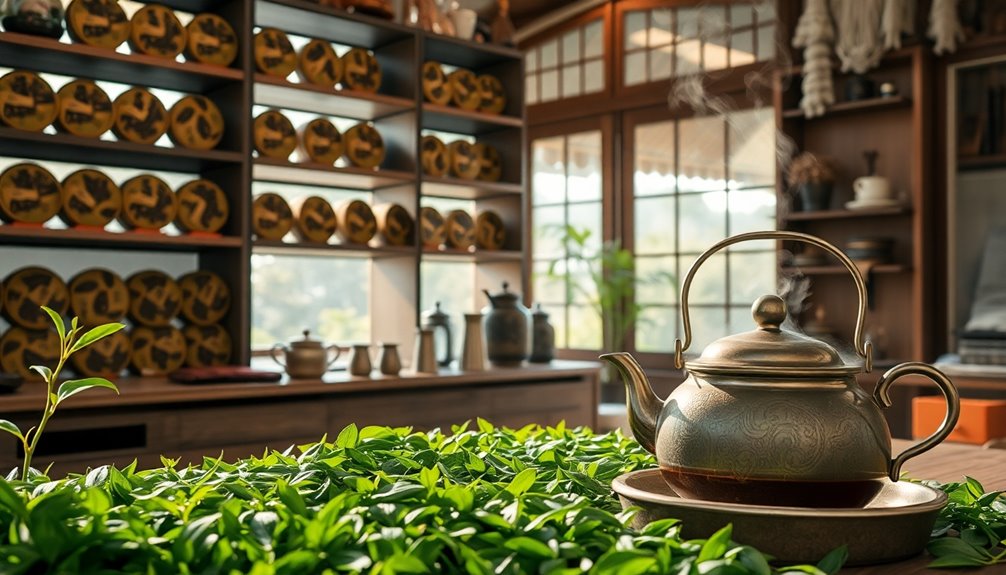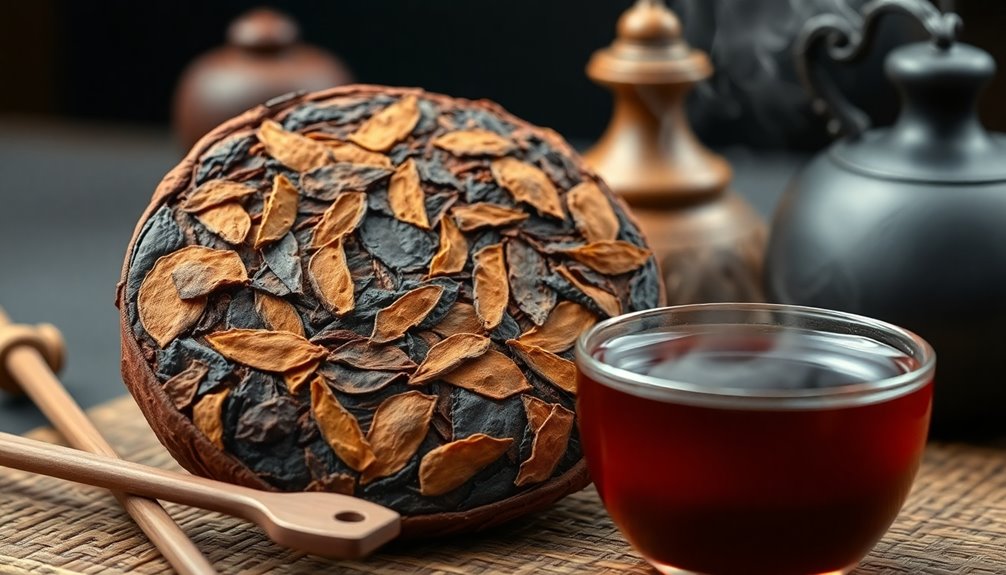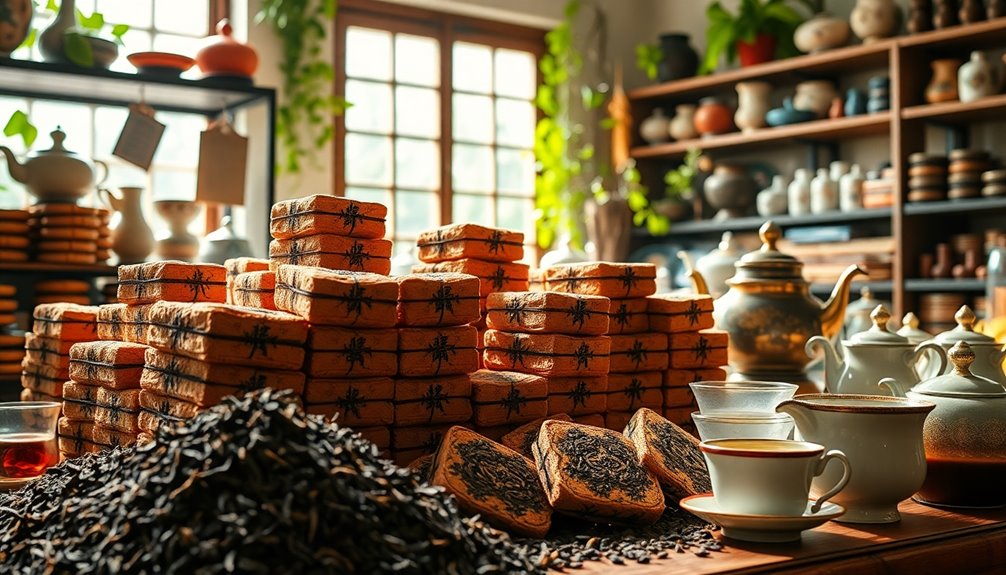To identify high-quality Pu-erh tea, start by checking its origin. Look for leaves from Yunnan, especially regions like Yiwu or Banzhang, and aim for larger, whole leaves without dust. The liquor should have a clear reddish-brown color, indicating cleanliness. Pay attention to the aroma; it should be rich and earthy with sweet notes, evolving with each steep. Also, understand fermentation methods, as well-executed processes enhance flavor. Finally, consider the price—higher prices often mean better quality. With these tips in mind, you're well on your way to finding a delightful Pu-erh experience! There's even more to explore!
Key Takeaways
- Look for high-quality Pu-erh from Yunnan's Large-leaf cultivar, ensuring a rich, authentic flavor profile.
- Inspect the liquor color; clear reddish-brown indicates cleanliness and quality.
- Choose whole leaves with minimal dust for better flavor and a premium experience.
- Seek aged tea from trees over 60 years old for added complexity and richness.
- Pay attention to aroma; a complex, layered scent with sweet and earthy notes signifies high quality.
Introduction

When it comes to appreciating the complexity of Pu-erh tea, understanding its quality is essential. High-quality Pu-erh starts with the right tea leaves, primarily from the Yunnan Large-leaf cultivar. Regions like Lincang and Xishuangbanna are known for producing some of the best.
You'll want to look for a clear reddish-brown liquor when you brew it—this indicates cleanliness and quality. The leaves should be whole, without excessive dust, to ensure a great flavor.
Aged tea, especially from old trees over 60 years old, offers unique complexity and depth. These trees absorb more nutrients, enhancing the tea's flavor profile. When you sniff the tea, you should notice a rich, earthy aroma with sweet undertones, showcasing its complex character.
Purchasing from reputable vendors is crucial. They should provide detailed information about the tea's origin, production methods, and grading. This way, you can be confident in the quality of the Pu-erh you're buying.
Understanding these factors will make your tea-drinking experience richer and more enjoyable. So, keep these tips in mind, and you'll be well on your way to identifying high-quality Pu-erh tea!
Origin of Tea Leaves

The origin of tea leaves plays a crucial role in determining the quality and flavor of Pu-erh tea. When you're looking for authentic Pu-erh tea, pay attention to where the leaves come from. Premium Pu-erh is mainly sourced from the Yunnan Large-leaf cultivar, with regions like Lincang, Xishuangbanna, Baoshan, and Puer (Simao) being key players.
The tea mountains today, such as Banzhang and Yiwu, are known for their unique conditions that significantly influence flavor profiles.
For higher quality Pu-erh tea, seek leaves from old tea trees, known as qiao mu, which are over 60 years old. These trees produce an ideal leaf combination of one bud plus two leaves, offering richer flavors and greater complexity.
You'll notice that older leaves tend to have a deeper, more vibrant color and an earthy aroma, which is a hallmark of authentic Pu-erh tea.
If you want to enjoy the best Pu-erh experience, remember that the origin of the tea leaves can tell you a lot about what's in your cup!
Aroma Intensity and Complexity

Aroma intensity and complexity are vital in distinguishing high-quality Pu-erh tea from the rest. When you take a whiff of high-quality Pu-erh, you'll notice a complex, layered aroma. Look for sweet notes, like dried fruits or honey, mingling with earthy undertones that showcase its natural origins.
Aged Pu-erh typically has a gentle, rich scent, free from mustiness, which indicates proper fermentation and storage conditions. As you explore the aromas, keep an eye out for fragrant woody scents that suggest higher quality.
However, be cautious of any fishy or moldy odors, as they clearly indicate poor storage and should be avoided. One exciting aspect of high-quality Pu-erh is how its aroma evolves over multiple infusions, revealing new layers of complexity with each steeping.
The intensity of the aroma should feel balanced; overly pungent or harsh scents might suggest inferior quality or improper processing. Finding the right Pu-erh means enjoying a delightful experience—where the aroma invites you to savor every sip!
With practice, you'll soon recognize the signs of a truly exceptional tea.
Fermentation Methods Impact Flavor

Understanding how fermentation methods impact flavor is crucial for appreciating high-quality Pu-erh tea. Shu pu-erh undergoes an accelerated fermentation process called "wo dui," which uses moisture and heat to mimic aging effects. This results in a bolder flavor profile than naturally aged sheng pu-erh.
Well-executed fermentation introduces beneficial microbial activity that enhances aroma and taste, giving high-quality shu pu-erh a clean, sweet aftertaste. On the other hand, poorly managed fermentation can introduce undesirable flavors, like fishy or moldy notes, indicating lower quality.
When properly fermented, aged shu pu-erh develops complex flavor notes, such as earthiness and sweetness. If the fermentation goes wrong, you might end up with a tea that tastes flat or overly pungent.
The duration and conditions of fermentation are key to the tea's smoothness and richness. High-quality Pu-erh should offer a well-rounded flavor that evolves pleasantly with each infusion.
As you explore different Pu-erh teas, pay attention to how fermentation methods impact the flavor. Choosing the right tea can lead to a delightful experience, allowing you to savor the intricacies of this unique beverage.
Pricing Discrepancies Among Producers

Fermentation methods not only shape flavor but also influence pricing in the Pu-erh market. When you're searching for high-quality Pu-erh tea, you'll notice some pricing discrepancies among producers. This is mainly due to the cultivation of older leaves from mature tea trees. These premium leaves require more labor and care, which raises their prices.
Also, specific regions like Yiwu or Banzhang are known for producing sought-after flavor profiles, making their teas cost more. The demand for these unique teas can drive prices even higher. Sometimes, producers blend different grades of leaves to craft specific tastes, and this mixing can impact the final price.
On the flip side, lower-priced Pu-erh teas might signal lower quality. They could be made from younger leaves or poorly stored, which can hurt the tea's flavor.
Always check storage conditions and remember that a higher price often reflects better quality tea. By keeping these factors in mind, you'll be better equipped to find high-quality Pu-erh tea that meets your taste and budget!
Practical Applications

When you're on the hunt for high-quality Pu-erh tea, there are several practical steps you can take to ensure you're making a wise choice.
First, examine the leaves closely. Good quality Pu-erh should have whole, clean leaves, free from excessive dust or foreign particles.
Next, take a moment to assess the aroma. You want pleasant scents, like sweet dried fruits or earthy notes. If you catch a whiff of anything fishy or moldy, it's a red flag for poor storage conditions.
Then, check the color of the tea liquor. High-quality pu-erh will present a clear reddish-brown hue, indicating cleanliness and proper fermentation.
Now it's time to taste! Good quality Pu-erh should feel smooth and have a natural sweetness. Look for a thick body and a lingering sweet aftertaste, avoiding any stale or unpleasant earthy flavors.
Frequently Asked Questions
How to Identify Good Puer Tea?
To identify good pu-erh tea, check for whole leaves that smell earthy, a clear reddish-brown liquor, and a smooth mouthfeel. Sourcing from reputable regions in Yunnan ensures quality, so avoid suspiciously low prices.
Are All Pu-Erh Teas the Same?
No, not all Pu-erh teas are the same. They differ in type, origin, age, and storage conditions. Each factor influences flavor and aroma, so you'll find a wide range of taste experiences.
How to Choose Puer?
When choosing pu-erh, consider sourcing from reputable regions, inspect the leaf quality for intactness, ensure proper storage, look at the price for value, and pick vendors who offer transparent information about the tea.
What Is the Best Source of Pu-Erh Tea?
When you're looking for the best source of Pu-erh tea, focus on Yunnan province. Regions like Yiwu and Jingmai offer exceptional flavors, especially from older tea trees harvested in spring for superior quality and aroma.
Conclusion
In conclusion, when you're looking for high-quality pu-erh tea, remember to check the origin of the leaves, smell the aroma, and understand how it's fermented. Pay attention to pricing, too; it often reflects the tea's quality. By following these tips, you'll be well on your way to enjoying a delicious cup of pu-erh tea. So, grab some leaves, brew a pot, and savor the rich flavors that this unique tea has to offer!










